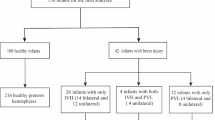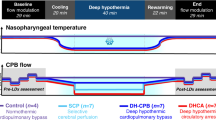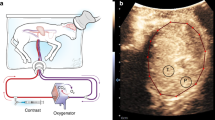Abstract
There is uncertainty about the level of systemic blood pressure required to maintain adequate cerebral oxygen delivery and organ integrity. This prospective, observational study on 35 very low birth weight infants aimed to determine the mean blood pressure (MBP) below which cerebral electrical activity, peripheral blood flow (PBF), and cerebral fractional oxygen extraction (CFOE) are abnormal. Digital EEG, recorded every day on the first 4 d after birth, were analyzed a) by automatic spectral analysis, b) by manual measurement of interburst interval, and c) qualitatively. CFOE and PBF measurements were performed using near-infrared spectroscopy and venous occlusion. MBP was measured using arterial catheters. The median (range) of MBP recorded was 32 mm Hg (16–46). The EEG became abnormal at MBP levels below 23 mm Hg: a) the relative power of the delta (0.5–3.5 Hz) frequency band was decreased, b) interburst intervals were prolonged, and c) all four qualitatively abnormal EEG (low amplitude and prolonged interburst intervals) from four different patients were recorded below this MBP level. The only abnormally high CFOE was measured at MBP of 20 mm Hg. PBF decreased at MBP levels between 23 and 33 mm Hg. None of the infants in this study developed cystic periventricular leukomalacia. One infant (MBP, 22 mm Hg) developed ventricular dilatation after intraventricular hemorrhage. The EEG and CFOE remained normal at MBP levels above 23 mm Hg. It would appear that cerebral perfusion is probably maintained at MBP levels above 23 mm Hg.
Similar content being viewed by others
Log in or create a free account to read this content
Gain free access to this article, as well as selected content from this journal and more on nature.com
or
Abbreviations
- CFOE:
-
cerebral fractional oxygen extraction
- MBP:
-
mean blood pressure
- PBF:
-
peripheral blood flow
- P90:
-
90th centile
References
Bada HS, Korones SB, Perry EH, Arheart KL, Ray JD, Pourcyrous M, Magill HL, Runyan W, Somes GW, Clark FC 3rd 1990 Mean arterial blood pressure changes in premature infants and those at risk for intraventricular hemorrhage. J Pediatr 117: 607–614
Miall-Allen VM, De Vries LS, Whitelaw AG 1987 Mean arterial blood pressure and neonatal cerebral lesions. Arch Dis Child 62: 1068–1069
Watkins AM, West CR, Cooke RW 1989 Blood pressure and cerebral haemorrhage and ischaemia in very low birthweight infants. Early Hum Dev 19: 103–110
Greisen G, Trojaborg W 1987 Cerebral blood flow, PaCO2 changes, and visual evoked potentials in mechanically ventilated, preterm infants. Acta Paediatr Scand 76: 394–400
Jorch G, Jorch N 1987 Failure of autoregulation of cerebral blood flow in neonates studied by pulsed Doppler ultrasound of the internal carotid artery. Eur J Pediatr 146: 468–472
Koyama K, Mito T, Takashima S, Suzuki S 1990 Effects of phenylephrine and dopamine on cerebral blood flow, blood volume, and oxygenation in young rabbits. Pediatr Neurol 6: 87–90
Lou HC, Lassen NA, Friis-Hansen B 1979 Impaired autoregulation of cerebral blood flow in the distressed newborn infant. J Pediatr 94: 118–121
Tyszczuk L, Meek J, Elwell C, Wyatt JS 1998 Cerebral blood flow is independent of mean arterial blood pressure in preterm infants undergoing intensive care. Pediatrics 102: 337–341
Greisen G, Pryds O 1989 Low CBF, discontinuous EEG activity, and periventricular brain injury in ill, preterm neonates. Brain Dev 11: 164–168
Scher MS 1999 Electroencephalography of the newborn: normal and abnormal features. In: Niedermeyer E, Da Silva FL (eds) Electroencephalography: Basic Principles, Clinical Applications, and Related Fields. Williams & Wilkins, Baltimore 896–946 pp
Hayakawa M, Okumura A, Hayakawa F, Watanabe K, Ohshiro M, Kato Y, Takahashi R, Tauchi N 2001 Background electroencephalographic (EEG) activities of very preterm infants born at less than 27 weeks gestation: a study on the degree of continuity. Arch Dis Child Fetal Neonatal Ed 84: F163–F167
Marret S, Parain D, Menard JF, Blanc T, Devaux AM, Ensel P, Fessard C, Samson-Dollfus D 1997 Prognostic value of neonatal electroencephalography in premature newborns less than 33 weeks of gestational age. Electroencephalogr Clin Neurophysiol 102: 178–185
Ichord RN, Kirsch JR, Koehler RC, Traystman RJ 1999 Cerebral anoxia: experimental view. In: Niedermeyer E, Da Silva FL (eds) Electroencephalography: Basic Principles, Clinical Applications, and Related Fields. Williams & Wilkins, Baltimore 432–444 pp
Wardle SP, Yoxall CW, Weindling AM 2000 Determinants of cerebral fractional oxygen extraction using near infrared spectroscopy in preterm neonates. J Cereb Blood Flow Metab 20: 272–279
Yoxall CW, Weindling AM, Dawani NH, Peart I 1995 Measurement of cerebral venous oxyhemoglobin saturation in children by near-infrared spectroscopy and partial jugular venous occlusion. Pediatr Res 38: 319–323
Wardle SP, Yoxall CW, Weindling AM 1999 Peripheral oxygenation in hypotensive preterm babies. Pediatr Res 45: 343–349
Parmelee AH Jr, Wenner WH, Akiyama Y, Schultz M, Stern E 1967 Sleep states in premature infants. Dev Med Child Neurol 9: 70–77
Jasper HH 1958 The Ten – Twenty Electrode System of the International Federation. Electroencephalogr Clin Neurophysiol 10: 371–375
Biagioni E, Bartalena L, Biver P, Pieri R, Cioni G 1996 Electroencephalographic dysmaturity in preterm infants: a prognostic tool in the early postnatal period. Neuropediatrics 27: 311–316
Victor S, Appleton RE, Beirne M, Marson AG, Weindling AM 2005 Spectral analysis of electroencephalography in premature newborn infants: normal ranges. Pediatr Res 57: 336–341
Wardle SP, Yoxall CW, Crawley E, Weindling AM 1998 Peripheral oxygenation and anemia in preterm babies. Pediatr Res 44: 125–131
Cunningham S, Symon AG, Elton RA, Zhu C, McIntosh N 1999 Intra-arterial blood pressure reference ranges, death and morbidity in very low birthweight infants during the first seven days of life. Early Hum Dev 56: 151–165
1992 Development of audit measures and guidelines for good practice in the management of neonatal respiratory distress syndrome. Report of a Joint Working Group of the British Association of Perinatal Medicine and the Research Unit of the Royal College of Physicians. Arch Dis Child 67: 1221–1227
Kissack CM, Garr R, Wardle SP, Weindling AM 2004 Cerebral fractional oxygen extraction in very low birth weight infants is high when there is low left ventricular output and hypocarbia but is unaffected by hypotension. Pediatr Res 55: 400–405
Munro MJ, Walker AM, Barfield CP 2004 Hypotensive extremely low birth weight infants have reduced cerebral blood flow. Pediatrics 114: 1591–1596
Pryds O, Greisen G 1990 Preservation of single-flash visual evoked potentials at very low cerebral oxygen delivery in preterm infants. Pediatr Neurol 6: 151–158
MacMillan V 1982 Cerebral Na+, K+-ATPase activity during exposure to and recovery from acute ischemia. J Cereb Blood Flow Metab 2: 457–465
Rosen I, Smith ML, Rehncrona S 1984 Quantitative EEG and evoked potentials after experimental brain ischemia in the rat; correlation with cerebral metabolism and blood flow. Prog Brain Res 62: 175–183
Watanabe K, Hayakawa F, Okumura A 1999 Neonatal EEG: a powerful tool in the assessment of brain damage in preterm infants. Brain Dev 21: 361–372
Author information
Authors and Affiliations
Corresponding author
Additional information
Supported by Newborn Appeal, Liverpool Women's Hospital, Liverpool, UK L87SS.
Rights and permissions
About this article
Cite this article
Victor, S., Marson, A., Appleton, R. et al. Relationship Between Blood Pressure, Cerebral Electrical Activity, Cerebral Fractional Oxygen Extraction, and Peripheral Blood Flow in Very Low Birth Weight Newborn Infants. Pediatr Res 59, 314–319 (2006). https://doi.org/10.1203/01.pdr.0000199525.08615.1f
Received:
Accepted:
Issue date:
DOI: https://doi.org/10.1203/01.pdr.0000199525.08615.1f
This article is cited by
-
EEG maturation and stability of cerebral oxygen extraction in very low birth weight infants
Journal of Perinatology (2016)
-
Effect of permissive hypercapnia on background cerebral electrical activity in premature babies
Pediatric Research (2014)
-
Premedication for intubation with morphine causes prolonged depression of electrocortical background activity in preterm infants
Pediatric Research (2013)
-
Definition of hypotension and assessment of hemodynamics in the preterm neonate
Journal of Perinatology (2009)
-
ROP surgery and ocular circulation
Eye (2008)



